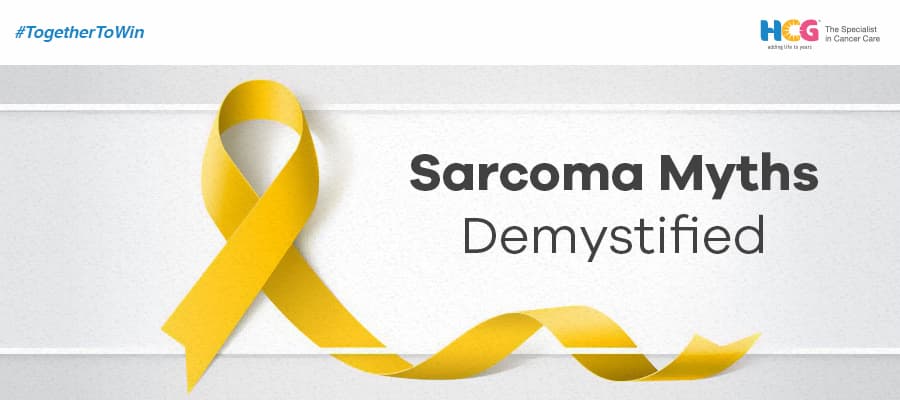
25 Jan, 2022

25 Jan, 2022
Sarcoma is a type of cancer that generally develops from tissues within the bone or muscle. The main types of sarcoma include bone and tissue sarcomas. Soft tissue sarcomas are a group of cancers that grow in your muscles, bones, deep layers of skin, or in fat. They can also occur in blood vessels, nerves or connective tissues, which support organs and other kinds of tissues. Soft tissue sarcomas are usually rare and account for less than 1% of all cancer cases. However, there are dozens of different types of soft tissue sarcomas that occur in children and adults.
Owing to how rare the condition is, a lot of myths and misconceptions about sarcoma exist. The amount of available information on the internet has made the situation worse. These myths and misconceptions can be extremely damaging to patients, causing panic and creating hurdles on the path to their recovery. Understanding the nuances of sarcoma and how it can be dealt with begins with debunking myths and misconceptions. Here are some common questions relating to sarcoma that will help you understand the condition better and seek medical attention when required.
No. Certain foods may enhance a body’s immunity to an extent but there is no single, specific food that can completely prevent sarcoma. Maintaining a balanced diet will ensure you receive a wide range of nutrients that your body needs and help keep it healthy. Steer clear of fats, oils, sugar and salt. Eat as many fruits and vegetables as possible.
A majority of malignant lumps are painless. By the time you feel pain, it is usually a sign that the sarcoma is at an advanced stage. For instance, in the case of bone sarcomas, a third of the bone must be destroyed for you to feel significant pain. In soft tissue sarcoma, there is generally no pain unless the tumour is pressing onto the nerves. Look out for these important signs while evaluating a lump:
No. There are presently no tumour marker blood tests to detect sarcoma. Present health screen tumour marker tests are limited in their scope and can check for certain cancers like liver cancer, ovarian cancer, pancreatic cancer, breast cancer, colorectal cancer and prostate cancer. There are none for sarcomas.
A biopsy will not cause sarcoma to spread. In fact, biopsies are very important because it helps doctors identify the specific type of cancer and what grade it is. Most biopsies these days are minimally invasive using core needle techniques. Percutaneous core needle biopsies are usually performed under radiology guidance for greater accuracy and to avoid injuring important organs.
Advancements in surgery, chemotherapy, clinical trials in new drugs, gene and stem cell therapy have increased the chances of survival for sarcoma patients even if they are diagnosed at advanced stages.
Fears related to sarcoma treatment are associated with the potential side effects of chemotherapy including hair loss and nausea. However, not all patients suffer hair loss and even if they do, the hair usually grows back well. There are drugs that take care of side effects like nausea which doctors prescribe to ensure a pleasant treatment experience.
Doctors always make limb preservation a priority when doing any surgery. While an amputation may be necessary in some cases, it is not so for every case. Today, there are also advanced methods of limb reconstruction using allografts from bones and megaprosthetic implants. They help patients lead active lives. Some implants also adapt to the growth of a body but can often be very expensive. Patients may believe that an amputation is a result of the treatment failing but this is not true. Sometimes a tumour is too large and it is not possible to preserve or reconstruct blood vessels for the limb to survive. In such cases, an amputation is essential for survival. Many amputees continue to have active lives based on their type of amputation and motivation and can partake in various sports.